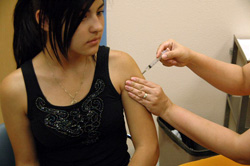Fogarty, NCI team up in Latin America
January - February, 2009 | Volume 8, Issue 1
The National Cancer Institute and Fogarty are teaming up to launch a three-year pilot program to focus on prevention and treatment of cancer in Mexico, Argentina, Chile, Brazil and Uruguay.
The new Office of Latin American Cancer Program Development within NCI will increase understanding about the burden of cancer in those countries, promote partnerships in both basic and clinical cancer research, and build relationships across all of Latin America to improve high-quality cancer research.

Photo by Sonia M. Mey, PAHO/WHO
A Latina teenager receives a vaccination
against human papilloma virus, a known
cause of cervical cancer.
“This program will result in a better understanding of cancer incidence and mortality in the diverse populations that make up Latin America,” says program director Dr. Jorge Gomez.
Dr. James Herrington, director of Fogarty’s international relations division, says, “Over time, what we learn in Latin America about cancer will improvement treatment of Hispanic populations in the United States and, ultimately, around the world.”
Globally, cancer cost 7.6 million lives in 2005, and is expected to cause 10.3 million deaths a year by 2020.
It is a leading cause of death worldwide, with over 7.6 million deaths attributed to the disease in 2005.
“Although cancer is generally considered to be a disease of high-income countries, migration and aging portend that cancer is increasingly becoming a major disease threat to developing nations,” Gomez says, noting that cancer trends in Latin America resemble those observed in U.S. Hispanics.
Gomez points out there is little evidence on how immigration may influence U.S. cancer trends. It is estimated that the U.S. Hispanic population will climb to 59.7 million and represent approximately 19 percent of the country’s population by 2020.
Cancer researchers are concerned that as developing countries acquire the diets and bad habits of upper-income countries, new cases will increase significantly in the coming years.
In Latin America, the high incidence of cancers associated with infectious agents—cervical, stomach, liver—can be limited through vaccines, antibiotics and improved sanitation, while lung cancer can be prevented through education about smoking, Gomez says.
“It is clear that Hispanics who relocate to the U.S. benefit from the preventive strategies employed for infectious agent-associated cancers such as gastric cancer; however, smoking-associated lung cancer remains the number-one killer in both populations,” according to the partnership’s strategic plan.
Overall, stomach cancer remains the major cancer causing mortality in most of these countries—a disease that can be nearly eradicated if appropriate diagnosis and treatment of the Helicobacter pylori bacterium can become part of clinical practice.
Prostate and breast cancers are also are prominent in the list of major cancers responsible for mortality, with the exception of Guatemala, where uterine cancer remains a major cause of death.
Learn more about the Office of Latin American Cancer Program Development (OLACPD).
To view Adobe PDF files,
download current, free accessible plug-ins from Adobe's website.